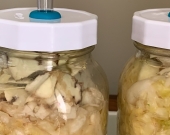
 1
1




 2
2




Whathever you are, be a good one.
___________________________________
 2
2




Whathever you are, be a good one.
___________________________________
 1
1









 1
1




It is a privilege to live, work and play in the traditional territory of the Salish People.
Now drop and give me 52... ~ Come Join the permies Shoecamp! ~ All about Permies, including Tutorials ---
Twenty bucks off the homesteading bundle for the next 72 hours!
 1
1









 1
1




 5
5




 1
1




Weeds are just plants with enough surplus will to live to withstand normal levels of gardening!--Alexandra Petri
 1
1




 3
3




In modern times the only right way forward is to come back to nature.
 2
2




I read that some molds can grow on the surface of the brine where there is oxygen, like mine had, but that it cannot survive under the brine, so theoretically any remnants of it would be killed by being mixed into the saurkraut/brine. Which it all would be now. But still not sure how I feel about it...






